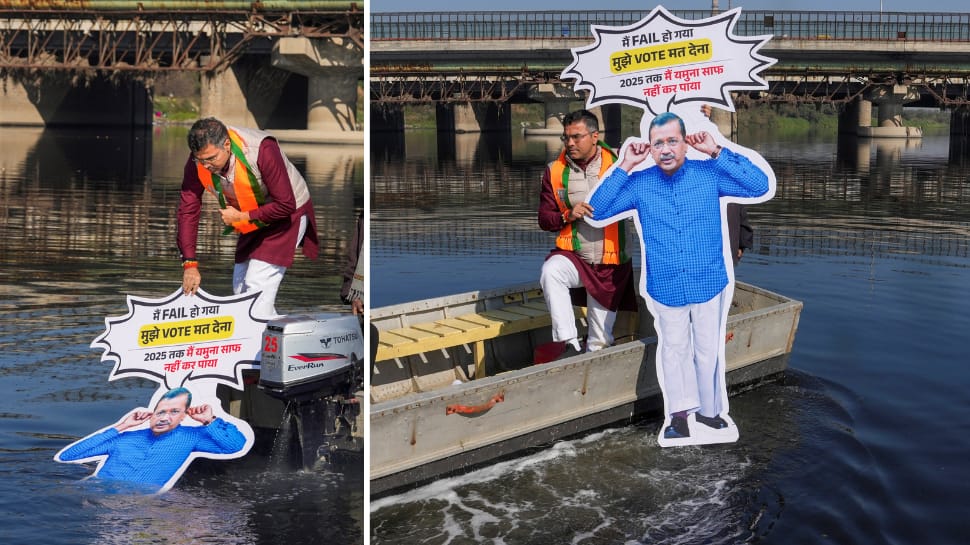 |
|
The upcoming Delhi Assembly elections have intensified the political battle over the severely polluted Yamuna River. The Bharatiya Janata Party (BJP), seeking to capitalize on public dissatisfaction with the Aam Aadmi Party's (AAP) handling of the environmental crisis, has employed a highly symbolic and visually striking tactic. BJP candidate Parvesh Verma dramatically submerged a life-sized cutout of Delhi Chief Minister Arvind Kejriwal into the Yamuna, a powerful visual representation of the party's accusations of AAP's failure to address the river's pollution. The poster depicted Kejriwal in an apologetic pose, with a message admitting failure to clean the Yamuna by 2025, a promise made by the AAP government.
Verma's act wasn't merely a symbolic gesture; it was a calculated political move aimed at garnering media attention and swaying public opinion. His accompanying statements provided a clear outline of the BJP's proposed solutions, including the removal of silt using machinery, the construction of new sewage and water treatment plants, and the development of a Yamuna Riverfront similar to the successful Sabarmati Riverfront project in Gujarat. This direct comparison served to highlight the BJP's purported competence in tackling large-scale infrastructure and environmental projects, implicitly contrasting it with the perceived inaction of the AAP government.
The Yamuna's polluted state has become a potent political weapon. The AAP's failure to deliver on its promise to clean the river by 2025 has fueled public frustration and provided ample ammunition for opposition parties. The BJP's campaign strategy highlights the contrast between its proposed solutions and the AAP's perceived lack of progress. This strategy resonates with voters who are increasingly concerned about the environmental and health consequences of the river's pollution. The incident also sparked a broader political debate, encompassing accusations and counter-accusations from various political players.
The controversy extended beyond the BJP and AAP. Uttar Pradesh Chief Minister Yogi Adityanath, while campaigning for the BJP in Delhi, harshly criticized Kejriwal for the Yamuna's condition, even questioning whether Kejriwal and his ministers had the courage to bathe in its polluted waters. This prompted a response from Samajwadi Party chief Akhilesh Yadav, who defended Kejriwal and questioned Adityanath's own ability to drink water from the Yamuna in Mathura. This exchange underscores the wider political implications of the Yamuna pollution issue, extending beyond Delhi's borders and highlighting the intense competition among political parties.
The Yamuna River's plight is not merely a political football; it represents a severe environmental and public health crisis. The persistent pollution poses significant risks to the health and well-being of Delhi's residents, impacting water quality, air quality, and overall public health. The ongoing political debate, while utilizing the issue for electoral gain, also serves as a reminder of the urgent need for effective and sustainable solutions to restore the river's health. The upcoming elections will be a crucial test for the voters' willingness to hold politicians accountable for their environmental promises and their commitment to addressing critical environmental challenges.
The BJP's strategy of utilizing the Yamuna's pollution as a central campaign issue reflects a broader trend in Indian politics, where environmental concerns are increasingly becoming pivotal electoral factors. The party's approach, combining symbolic actions with detailed policy proposals, exemplifies a sophisticated campaign technique geared towards capitalizing on public discontent. However, the effectiveness of this approach remains to be seen. While the visual impact of the stunt may garner immediate attention, long-term solutions will require a concerted effort from all stakeholders, including the government, civil society, and the public.
The upcoming elections will not only decide the fate of the AAP government but also serve as a barometer of the public's priorities. The prominence of the Yamuna pollution issue highlights the growing awareness and concern surrounding environmental issues among Indian voters. The political rhetoric surrounding the river's pollution is likely to continue intensifying as the election draws closer. This event underscores the complex interplay between politics, environment, and public health, and emphasizes the urgent need for concrete and effective policies to tackle this critical issue.
In conclusion, the incident involving the submersion of Kejriwal's cutout serves as a microcosm of the broader political battle in Delhi. The Yamuna River's polluted state has become a central point of contention, shaping the political narratives of various parties and highlighting the crucial intersection of environmental concerns and electoral politics. The outcome of the election will not only determine the next government but will also reflect the electorate's response to the environmental crisis and the promises made by the participating political parties. This incident will undoubtedly be remembered as a defining moment in the 2025 Delhi Assembly Elections.
Source: BJP Dunks Kejriwal’s Poster In Yamuna As Pollution Politics Heat Up: ‘Main Fail Ho Gaya...’
